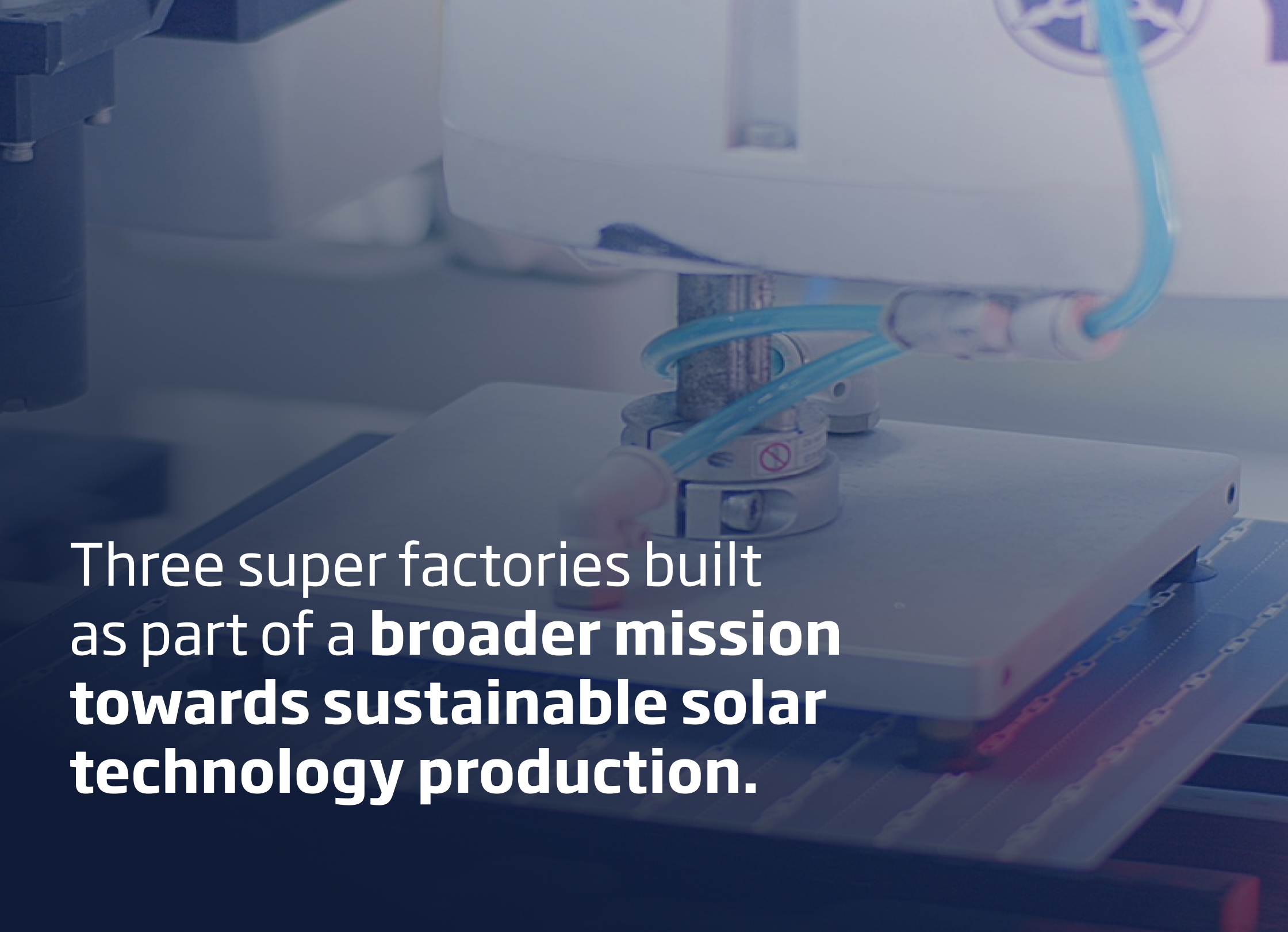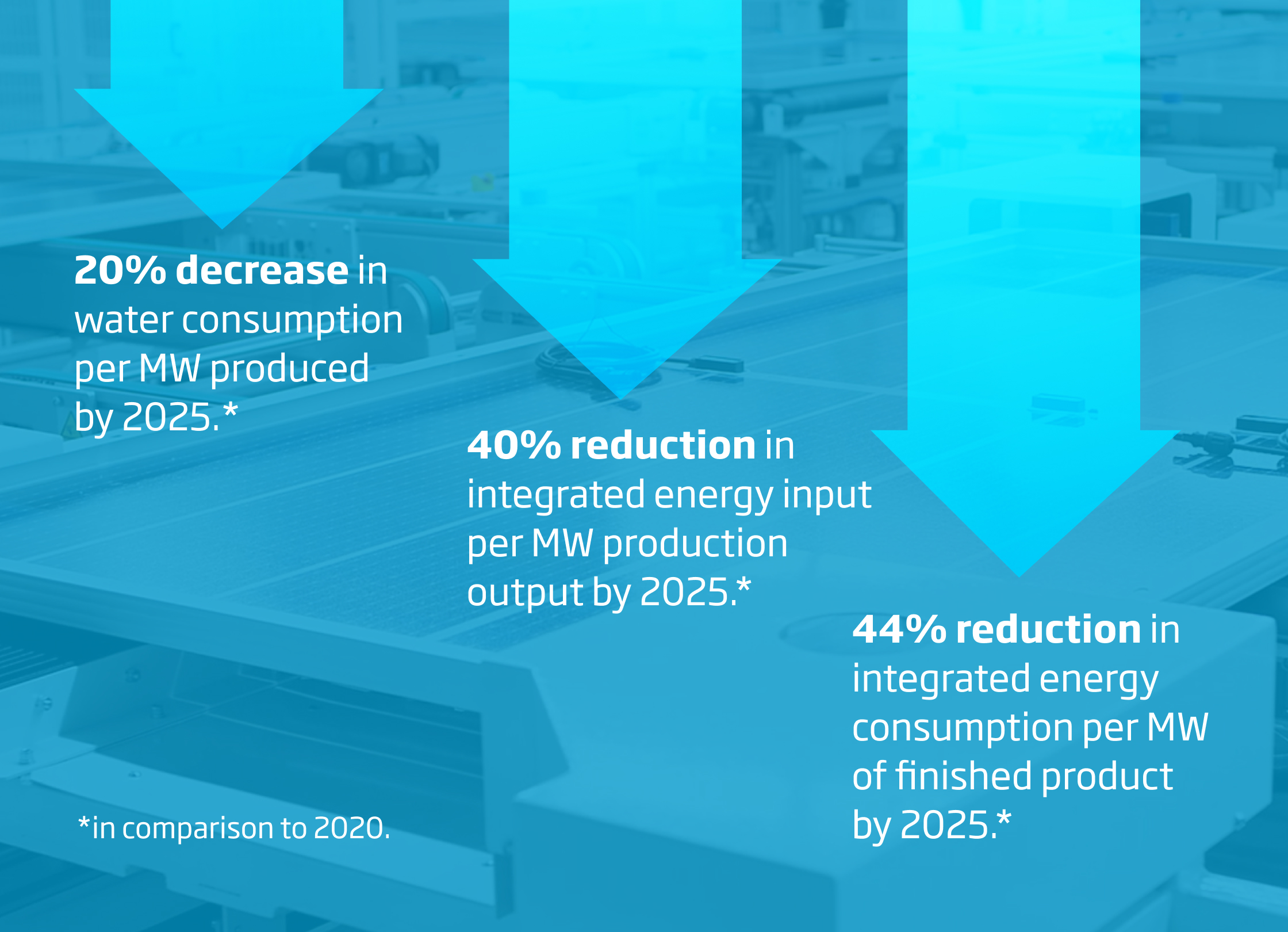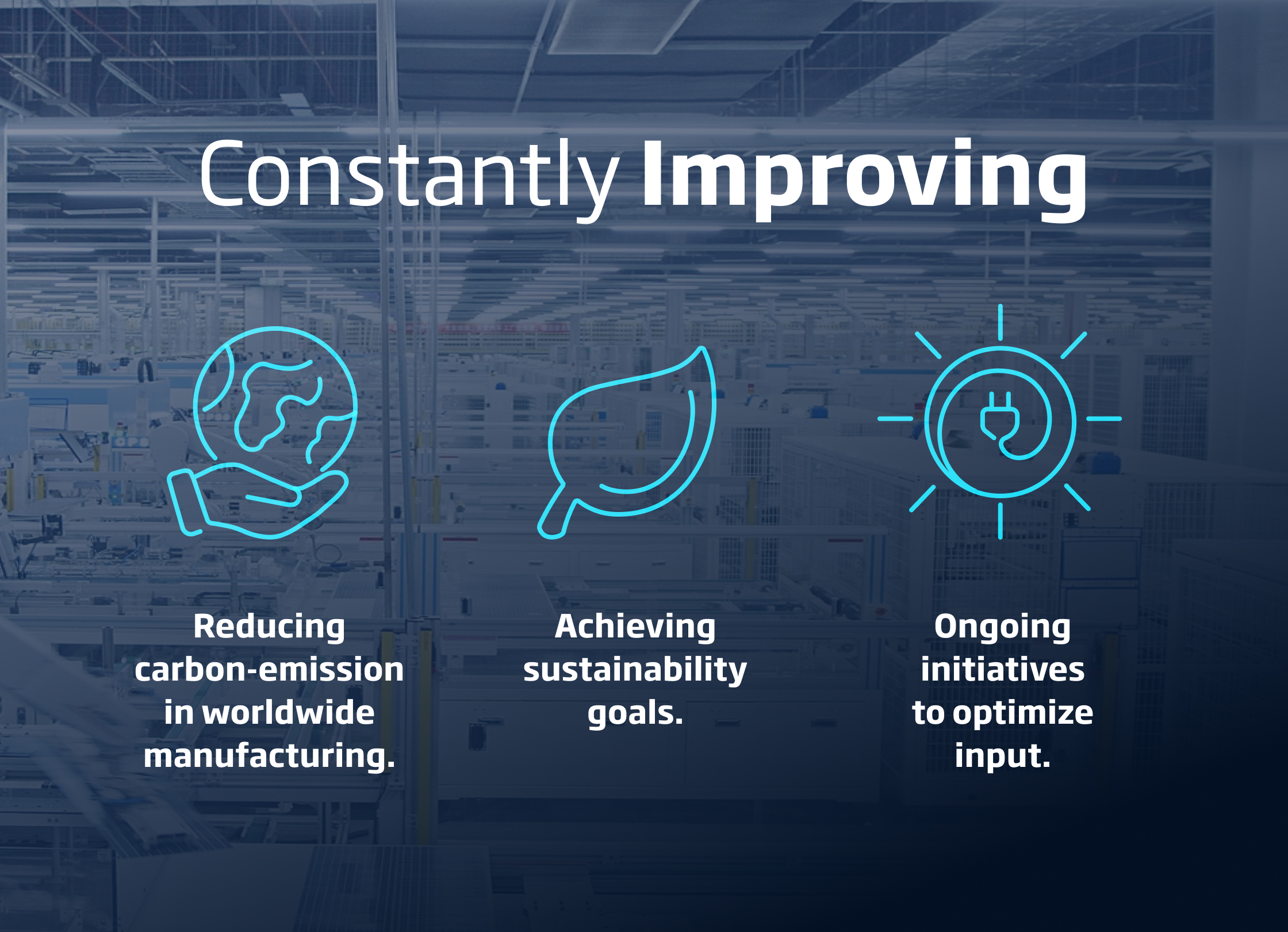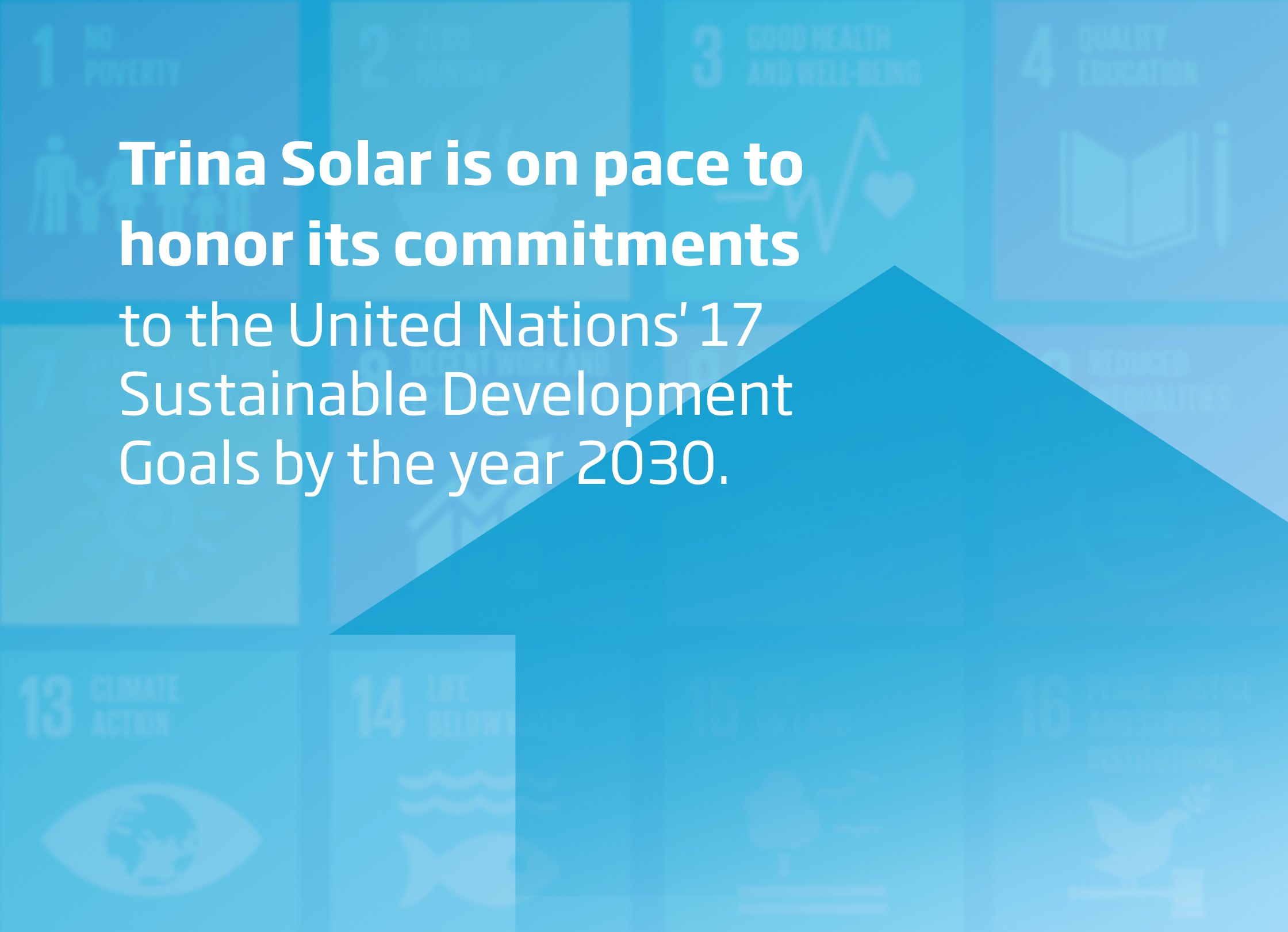Less Input, More Output: Responsible Use of Valuable Resources in Solar Manufacturing
- 23/09/25
- Innovation and Advance,Business of Solar,Panel Talk and Technology,Responsible Earth,Trina Success
Since its establishment in 1997, Trina Solar has been the trailblazer of achievements in sustainable manufacturing, both in terms of technological developments and production standards. As a worldwide leader in the production of solar photovoltaic modules and smart energy solutions, the company has served as a significant contributor to global efforts towards a future with more sustainable energy. Today, Trina Solar is proud to support the United Nation’s sustainable development goals in view of 2030, having already integrated specific goals into its global operations.
As part of the company’s ongoing sustainability initiatives, Trina Solar is committed to optimizing all resources used in its global manufacturing operations and reducing its overall carbon footprint. This initiative has two key components. First, Trina Solar is committed to achieving lasting sustainability in its input, namely through sustainable usage of water, energy and raw materials during production. Second, Trina Solar manages its overall output by reducing various forms of waste produced in the company’s operations. By improving both input and output as parallel goals in a broader initiative, Trina Solar is on pace to achieve fully optimized resource usage, significantly reduce its environmental footprint, and adhere to its major sustainability goals through 2030.

Managing Input
A major aspect of Trina Solar’s ongoing sustainability effort is a commitment to the responsible use of valuable resources in solar manufacturing. To date, Trina Solar has already constructed three “super factories” as part of its broader mission towards sustainable solar technology production. Not only can each super factory produce high-end solar modules, but they also represent a significant move towards sustainable input during the production process.
Trina Solar is currently moving towards actionable goals on its overall production input. These sustainability initiatives correspond to three main components of necessary input to the production process. Currently, solar manufacturing requires the input of energy, water, and raw materials. By focusing on reducing the usage of these three input components during solar production, Trina Solar is moving much closer to achieving its sustainability goals.

Energy management
From its very beginnings, Trina Solar has committed to maintaining low-carbon operations at all its factories and production sites. During all ongoing production, Trina Solar enacts comprehensive internal assessments to get a clear picture of the company’s energy consumption. These assessments correspond to the company’s rigorous rules and procedures, including the Energy & Resource Management Procedure, the Energy Measurement and Management Procedure, and the Energy Review Procedure.
Thus, Trina Solar is currently on pace to achieve a 40% reduction in integrated energy input per MW production output by 2025, compared to 2020. This decrease corresponds to the manufacturing of Trina Solar’s solar photovoltaic, cell, and module products. In addition, Trina Solar has seen significant reductions in energy consumption year after year. From 2020 to 2022, Trina Solar’s overall integrated energy consumption per MW of finished product was successfully reduced by 44%.
Water management
While energy consumption is often the most prominent aspect of sustainability initiatives, water management is also extremely important. Climate change, global population increases, and other interrelated factors all place greater strains on worldwide water resources each year. Companies looking to achieve greater sustainability must t work towards comprehensive water management goals.
Trina Solar complies fully with all water-usage laws and regulations in all countries where it operates. But that’s just the starting point: The company has also undertaken successful initiatives to reduce overall water consumption during its production processes. By investing in production technologies with much greater efficiency in water usage, Trina Solar not only reduces its water consumption but also helps effect a broader reduction in water usage throughout worldwide manufacturing operations.
Compared to Trina Solar’s water consumption levels in 2020, the company is currently projected to achieve a 20% decrease in water consumption per MW produced by 2025 for manufacturing of all solar photovoltaic products, including both cells and modules.
Raw materials
Finally, Trina Solar recognizes that sustainable production of solar energy technology requires the sustainable selection and usage of all raw materials. As a part of its initiative towards reduction in raw material input, we have placed company-wide emphasis on rigorous waste material recycling practices.
Today, Trina Solar works closely with upstream material suppliers to keep close track of recyclable materials and ensure that no materials are disposed of or wasted outside of available recycling procedures. Trina Solar is also committed to maximizing the use of recyclable materials in the company’s packaging.
Thanks to this initiative, Trina Solar now uses packaging composed of recyclable materials such as cardboard or wood boards. To integrate further sustainable usage of raw materials, Trina Solar has implemented a company-wide “Packaging Material Recycling Operation Guideline,” which helps ensure the maximum reduction in raw material usage for all packaging.

Managing by-product
Within the broader framework of global sustainability initiatives, Trina Solar recognizes the importance of reducing a company’s waste output and lowering its overall environmental footprint. While the optimization of resources used in manufacturing operations is essential to achieving sustainability, a company must also ensure that it adequately reduces its waste output to become truly sustainable.
To this end, Trina Solar has embarked on additional initiatives to manage and ultimately reduce the output of its operations. While solar technology production has historically produced a degree of waste, Trina Solar is committed to significantly reducing its own emissions and leading the global development of sustainable production operations.
Waste water management
Water consumption and the reduction of water inputs are major factors in the production of solar panel technology. Solar companies must also take significant steps to manage their wastewater output if they wish to achieve a comprehensive reduction in their environmental footprint. Therefore, we have implemented several rigorous procedures to greatly minimize wastewater output during our production operations.
Trina Solar’s sewerage disposal measures are designed to ensure that the wastewater output of Trina Solar factories is sent to qualified facilities for recycling and/or treatment. Any wastewater that cannot be treated and recycled is only discharged once it meets essential environmental standards. In a related initiative, Trina Solar has also taken steps to separate all rainwater from sewage networks, which ensures that potential waste liquids are not discharged into rainwater networks. This process has also involved major advancements in Trina Solar’s cleantech to reduce the discharge of pollutants and increase the efficiency of raw material usage.
Thanks to these initiatives, Trina Solar has achieved significant reductions in wastewater output during its production operations. From 2020 to 2022, Trina Solar successfully reduced its industrial wastewater discharge from 1,075,000 tons to 833,000 tons per MW of finished product. Specific wastewater management initiatives include Trina Solar’s work towards more efficient recycling of concentrated water in its Suqian cell production base, which saves up to 370,000 tons of annual water withdrawal. Another major water management initiative saw Trina Solar reutilizing concentrated and condensed water in a large production site, which resulted in annual water withdrawal savings of up to 740,000 tons.
Exhaust gas and solid waste management
Trina Solar has taken major steps towards large-scale industrial carbon emission reduction in its worldwide manufacturing. This includes significant initiatives to manage and reduce both exhaust gas and solid waste output.
One of the company’s most significant initiatives toward sustainable management of solid waste is the company-wide Waste Management Procedure. Under this procedure, all Trina Solar factories and operational locations carefully supervise the collection, storage, transfer, and disposal of all waste materials. A major component of this procedure is the comprehensive classification of all solid waste material into categories: industrial solid waste, domestic waste, and hazardous waste. Once a particular solid waste material has been classified into one of these categories, Trina Solar is better able to ensure that it is stored, treated, or disposed of in the most environmentally-sustainable manner.
Trina Solar has also undertaken extensive initiatives to manage and reduce all exhaust emissions per environmental laws and ongoing global sustainability goals. The main emissions resulting from the manufacture of solar technology are greenhouse gases, particulate matter, and nitrogen oxides. To reduce the output of these emissions, Trina Solar has installed advanced sensing devices at its production bases to monitor all emission outputs from factory production.
This sensing technology provides the means to identify untreated gas emissions before they are released and ensure that no exhaust gas emissions violate relevant environmental laws or sustainability initiatives. Thanks to innovative strategies such as these, we have successfully reduced exhaust emissions from our production sites. For example, Trina Solar has cut its specific nitrogen oxide emissions from 6.53 tons in 2021 to only 2.7 tons in 2022. Trina Solar maintains these high standards through regular gas emission reports, which allows the company to ensure that all solar modules produced in its factories meet essential gas discharge standards.
Advancing Major Sustainability Goals
Trina Solar's ongoing initiatives to optimize input and output represent a major step towards achieving broader sustainable development goals. Thanks to these initiatives, Trina Solar is well on pace to honor its commitments to the United Nations' 17 Sustainable Development Goals by the year 2030. By achieving the sustainable production of solar power technology, Trina Solar can both reduce its own environmental footprint and facilitate greater energy sustainability across the globe.


